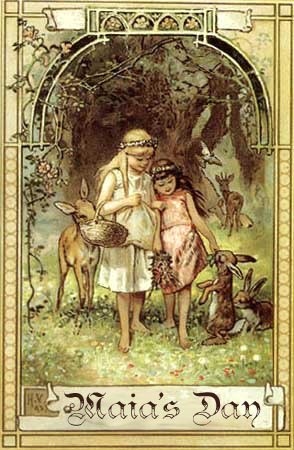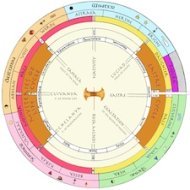The Day of Maia

Maia is the first person of the Werde Triplicity. Each member of this Triplicity has her own festival day during the year.
Maia is the creative principle and thus (in a minor sense) related to the concept of the Mother-Creatrix in the feminine Holy Trinity itself.
However, it must be understood that while the Mother is both Essence and Substance, Maia governs more the substantial aspect of creation.
While the name Maia can be taken (in Tellurian terms) to be Graeco-Roman, it is also found in Sanskrit (as Maya) where it refers to the world-illusion. In Classical myth Maia is the mother of Hermes/Mercury. In Buddhism, Maya is the name of the mother of the Buddha. Naturally, both Hermes/Mercury and the Buddha (derived from Budhi – the planet Mercury) are names of Sai Mati.
Why is Sai Mati seen as the daughter of Sai Maia? In Tellurian tradition, this is perhaps best explained with reference to Vedantic Sankhya philosophy, which shows that "the first degree of the manifestation of Atma is Buddhi, the higher Intellect" and that Buddhi, viewed in relation to the domain of individual manifestation (our domain) is its immediate but transcendent principle, just as the subtle domain, or Anima Mundi is the immediate but transcendent principle of manifestation as a whole.
In other words, since Sai Maia is the very basis of the projection of Essence or the Supreme Spirit (Atma) into manifestation, her very first production must be Sai Mati, the higher Intellect (Buddhi) which is the transcendent principle of all other manifestation.
Returning to Sai Maia herself, she is the all-creative principle. She is associated with ignorance, or nescience, because if we could see truly we would see through the world-illusion of manifestation and see that in truth there is only the Spirit, our Mother God.
However, in feminine thealogy, this "illusion" and "nescience" is not regarded as a purely negative thing as it is in some of the more world-denying patriarchal doctrines. It is far more subtle, since the world is the beautiful and generous manifestation of Our Mother God, allowing us to enjoy Her bounty and loveliness at the spiritual level we currently find ourselves.
As it says in the Devi Gita:
Through Thy power of nescience doth the world appear, like to a rope appearing as a serpent or as a garland of flowers.
Through Thy power of Knowledge Thou dissolvest the world back into Thine own Self.
Glory unto Thee, great Empress of the Universe. This really sums up the dual understanding of Sai Maia in traditional feminine religion. Maia is Dea's "power of nescience" – that is both (in a certain sense) illusory and also all-creative. The world may be illusion, but it is a beautiful dream created for us by our loving Mother – and whether She is creating the world of Maya (Maia) or delivering us through Pure Knowledge, this is all part of Her Divine play.
The analogy of mistaking a rope for a serpent (referring to mistakenly seeing the material universe, which is but illusion) is common to Vedantic writing, but only in the feminine Scriptures is its positive aspect also stressed: "as a serpent or a garland of flowers" – for flowers, with all their variety, color, form and abundance are the perfect symbol of the vast, opulent beautiful and loving creativeness of Our Mother God.
The Day of Maia is the celebration of that loving abundance and, not accidentally, it is also celebrated as a flower festival. As the year begins to blossom in every way, we celebrate the beauty and generosity of Our Mother's manifested universe – the garland of flowers she has given to her children.
See also:
Maia: the Angel, the Month and the World-Illusion
Send us your questions or comments
Chapel of Our Mother God Homepage
All written material at the Chapel of Our Mother God is copyright. Should you wish to reproduce any portion please contact us for permission.
Facebook or Twitter
Wheel of the Year
Articles on the Months, Seasons and Festivals of the year in feminine religion General The High Feast of EastreThe End/Beginning of the Cycle
- All about Eastre: The Last Festival and the First
- An Easter Hymn
- The Marianna Maria Chant
- The True Meaning of the Eastre Egg
- Chelanya: The Feast of Regeneration
- Cuivanya: The Feast of Divine Life
- Tamala: The Feast of the Dead
- All about Nativity
- The Birth of God the Daughter
- Winter Solstice
- The True Meaning of Christmas
- Amaterasu Omikami and the Spiritual Meaning of Midwinter
- The "Christmas Tree"
- The real Christmas Tree Angel
- "Hail to the Princess" carol
- The Day of Our Sovereign Lady
- Maia's Day
- The Day of Werde
- Early Winter Festivals
- The Conception of God the Daughter
- The Day of Sai Herthe
- The Epiphany of Our Lady
See the Wheel of the Year Click below to see the full image of the Sacred Year, or go here for a basic introduction.

Click to enlarge
Once you have enlarged the image you can use the Ctrl + and - keys (Command + and - on a Mac) to resize the Wheel to your exact requirements.Visit the Sun Daughter Press Reading Room